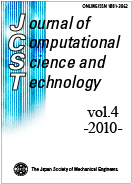4 巻, 3 号
選択された号の論文の5件中1~5を表示しています
- |<
- <
- 1
- >
- >|
Papers
-
2010 年 4 巻 3 号 p. 147-158
発行日: 2010年
公開日: 2010/08/13
PDF形式でダウンロード (1215K) -
2010 年 4 巻 3 号 p. 159-171
発行日: 2010年
公開日: 2010/08/13
PDF形式でダウンロード (2158K) -
2010 年 4 巻 3 号 p. 172-184
発行日: 2010年
公開日: 2010/08/13
PDF形式でダウンロード (1963K) -
2010 年 4 巻 3 号 p. 185-193
発行日: 2010年
公開日: 2010/09/15
PDF形式でダウンロード (608K) -
2010 年 4 巻 3 号 p. 194-206
発行日: 2010年
公開日: 2010/09/24
PDF形式でダウンロード (992K)
- |<
- <
- 1
- >
- >|
